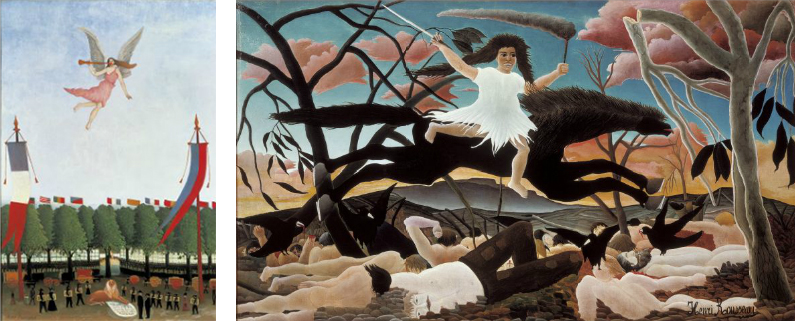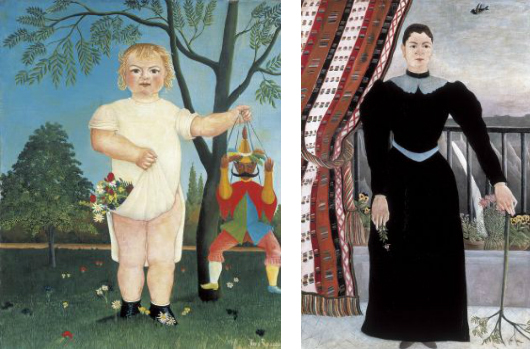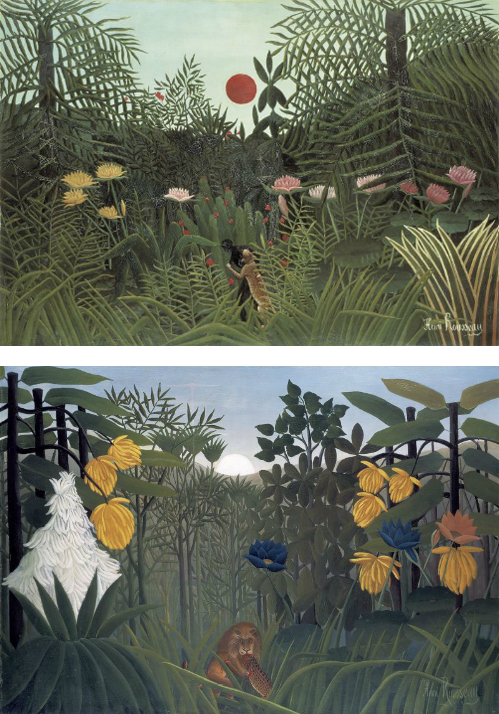Henri Rousseau: Jungles in Paris

Introduction
Henri Rousseau's modest background belied his aspirations. Born in 1844 in Laval, a market town in northwest France, he was a provincial transplant to Paris who was impoverished for most of his life. He worked as a customs clerk on the outskirts of the city, a post that earned him the nickname Le Douanier (the customs agent). A self-taught artist, Rousseau was unable to paint full time until his retirement in 1893. Despite these inauspicious circumstances, he hoped to join the refined artists of the staunchly conservative French Academy.
As an outsider, however, Rousseau was less familiar with the rules of the artistic establishment. Although he worked in traditional genres, producing landscapes, portraits, allegories, and exotic scenes, they were transformed in his hands, made odd in ways that provoked both derision and admiration. In contrast to academic artists, Rousseau brought to ambitious painting an openness to the materials of popular culture—illustrated magazines, dime store adventure novels, postcards, and photographs—often integrating their strong graphic quality and dramatic subject matter into his work.
Rousseau was best known for his bold pictures of the jungle, teeming with flora and fauna. Yet this painter of exotic locales never left France, notwithstanding stories to the contrary. His paintings were instead the concoctions of a city dweller, shaped by visits to the botanical gardens, the zoo, and colonial expositions as well as images of distant lands seen in books and magazines. A counterpoint to his pictures of a tranquil and familiar Paris, these images of seductive and terrifying faraway places reflected the desires and fears of new modern world.
In the end, Rousseau's work found enthusiastic acceptance outside the establishment: he was championed by a younger generation of avant-garde artists and writers, including Alfred Jarry, Guillaume Apollinaire, Robert Delaunay, and Pablo Picasso, who admired the liberties he took, seeing in them new possibilities for the future.
Tropical Forest with Monkeys, 1910, oil on canvas, John Hay Whitney Collection, 1982.76.7

Surprised!
Tiger in a Tropical Storm (Surprised!) was Rousseau's first jungle painting. Although Rousseau never witnessed anything like the scene rendered, the subject matter was not unusual for its time, especially among academic painters, who regularly depicted exotic subjects. Exhibited at the Salon des Indépendants in 1891, the painting was ridiculed for its amateurish technique and childlike naïveté. But it also gained Rousseau his first serious review, from the young painter Félix Vallotton: "His tiger surprising its prey is a 'must-see'; it's the alpha and omega of painting and so disconcerting that, before so much competency and childish naïveté, the most deeply rooted convictions are held up and questioned." Yet it was more than a decade before Rousseau returned to the jungle theme.
Tiger in a Tropical Storm (Surprised!), 1891, oil on canvas, The National Gallery, London

Forests
Rousseau's forest paintings shown here were among the earliest works that Rousseau exhibited in public. Refused entry to the official, juried Salon exhibition, he took advantage of the newly established annual Salon des Indépendants, which was open to all. Rousseau showed his work in this alternative exhibition nearly every year from 1886, with his submission of Carnival Evening, until his death in 1910.
These first submissions elicited mockery and sarcasm from critics and the public alike, who were baffled by his strangely theatrical images of people—sometimes in elaborate costumes—inexplicably situated in an enveloping forest. Equally perplexing was his disregard for perspective, with foreground, background, and middle ground seeming to coexist on a single plane, like backdrops on a stage. Tinged with both enchantment and menace, these early works foreshadowed his jungle paintings. As one critic wrote, Rousseau's forest is "the virgin forest with its terrors and its beauties, that we dream of as children...[it is] the virgin forest as a creation of fantasy."
Carnival Evening, 1886, oil on canvas, Philadelphia Museum of Art, The Louis E. Stern Collection, 1963 © Philadelphia Museum of Art

Suburban Landscapes
The son of an ironmonger from the northwestern market town of Laval, Rousseau had a humble background. He moved to Paris in 1868 and eventually became a clerk for the Paris municipal customs service. For years Rousseau's artistic endeavors were limited to his work as a Sunday amateur, but at age forty-nine he retired from his customs post to paint full time. Although he directed much of his effort toward large-scale canvases for Salon submissions, Rousseau also needed to sell paintings to support himself. With that in mind, he produced numerous modest-sized canvases of suburban Paris, which he sold for equally modest sums, often exchanging them with local merchants for groceries or services. For these small paintings Rousseau chose subjects designed to appeal to his petit-bourgeois clientele, who sought familiar scenes to decorate their homes.
While Rousseau's suburban landscapes are punctuated with signs of modernity (smokestacks, telephone poles, factories), his views of Paris are devoid of the bewildering chaos of the modern metropolis. Instead the artist offers a tranquil vision of a capital where citizens stroll through parks, relax on boating excursions, and fish along riverbanks. The calm, cultivated views of suburban Paris provide a contrast to his emotionally charged images of exotic jungles. Yet the eerie stillness of these suburban landscapes and their odd leaps in scale make the familiar seem strange.
(top left) The Customs Post, c. 1890,oil on canvas,The Samuel Courtauld Trust,Courtauld Institute of Art Gallery, London © Courtauld Institute of Art
(top right) Banks of the Oise, 1905, oil on canvas, Smith College Museum of Art, Northampton, Massachusetts. Purchased with the Drayton Hillyer Fund, Photo by Stephen Petegorsky
(bottom left) Avenue in the Park at Saint-Cloud, 1908, oil on canvas, Städtische Galerie im Städelschen Kunstinstitut, Frankfurt am Main Artothek
(bottom right) View of the Quai d'Ivry Near the Port à l'Anglais, Seine (Family Fishing), 1900, oil on canvas, The Baltimore Museum of Art
The Cone Collection, formed by Dr. Claribel Cone and Miss Etta Cone, of Baltimore, Maryland, BMA, 1950.294 © The Baltimore Museum of Art

Allegories
A number of Rousseau's works express his national pride. Although most avant-garde artists of the period opposed the shaky and ineffective government of the newly formed Third Republic, Rousseau—like many in his social class—was an ardent supporter, who took its patriotic rhetoric at face value. He courted its cultural authorities with works such as The Representatives of Foreign Powers Coming to Greet the Republic as a Sign of Peace, which depicts France as a benevolent global power bringing peace and civilization to the world.
In addition to seeking state recognition, Rousseau craved acceptance by the artistic establishment. For this reason, he turned to allegory, long held to be the pinnacle of artistic achievement and a mainstay of the official Salon. He produced large-scale canvases that used personification and symbols to address serious subjects of historical significance, such as liberty and war. While Rousseau's allegorical paintings depict such lofty themes, his humble, idiosyncratic style seems incongruous with the high-minded genre.
(left) Liberty Inviting Artists to Take Part in the 22nd Exhibition of the Société des Artistes Indépendants, 1905-1906, oil on canvas, The National Museum of Modern Art, Tokyo © The National Museum of Modern Art, Tokyo
(right) War, 1894, oil on canvas, Musée d'Orsay, Paris © Photo RMN - Droits reserves

The Representatives of Foreign Powers Coming to Greet the Republic as a Sign of Peace
Rousseau's imaginary ceremony depicts Marianne, the personification of the French Republic, towering over a group of past and present heads of state, including King Edward VII, Tsar Nicholas II, and Kaiser Wilhelm II–figures who never would have all gathered in real life. In the background children representing France's "young" colonies dance around the statue of Etienne Dolet, the sixteenth-century thinker executed for his unorthodox religious views.
Marianne – the personification of the French Republic – wears the red cap of the French Revolution and stretches her left arm to extend an olive branch. Olive branches are also seen along the bottom of the painting in cones that bear the mottoes of the new Republic: “peace,” “work,” “liberty,” and “fraternity.”
Rousseau assembled an illustrious group of heads of state, including King Edward VII, Tsar Nicholas II, Franz-Joseph of Austria, Kaiser Wilhelm II, the Shah of Persia, and six different presidents of the Republic. Rousseau presented these figures as if he were documenting a historical moment, but in fact these personages never all gathered together in Paris.
The figures here are personifications of the French colonies in Madagascar, equatorial Africa, Indochina, and North Africa. The “young” colonies are also represented in the children dancing around the statue to the right. Such a peaceful presentation glossed over the more destructive aspects of French colonialism.
The statue portrays Etienne Dolet, the sixteenth-century thinker executed for his unorthodox religious views. In 1906, soon after Church and State in France had officially separated, this statue of a martyr for “free thought” was a loaded symbol.
The Representatives of Foreign Powers Coming to Greet the Republic as a Sign of Peace, 1907, oil on canvas, Musée Picasso, Paris

Portraits
Rousseau's portraits represent some of his most disconcerting paintings. His depictions of children are especially unnerving: fiercely independent, with adult demeanors, they appear neither playful nor innocent. Rousseau also gave his sitters peculiar props, such as an oversized marionette or an upturned branch used as a cane. In traditional portraits such props are often symbolic, but here they resist explanation. This, along with puzzling settings and alienating expressions, lend the sitters an unfamiliar, mysterious air and make the established genre of portraiture seem strange as well.
(left) To Celebrate the Baby, 1903, oil on canvas, Kunstmuseum Winterthur, Inv. Nr. 1103, Presented by the heirs of Olga Reinhart-Schwartzenbach, 1970 © Kunstmuseum Winterthur
(right) Portrait of a Woman, 1895, oil on canvas, Musée Picasso, Paris © Photo RMN / © René-Gabriel Ojéda


Dangerous Exotic
A number of 1903 exhibitions memorializing Paul Gauguin—by then well known for his Tahitian paintings—may have triggered Rousseau's return to the jungle theme. It was with these later tropical jungle pictures, painted from 1904 until his death in 1910, that Rousseau finally secured a measure of critical recognition. Many of these paintings depict scenes of violence, particularly of animal combat. In part this reflected the image of the "savage exotic" put forward in colonial literature and seen in the work of artists such as Eugène Delacroix, who also made several paintings of animals fighting. Yet even the most threatening of Rousseau's jungle pictures, with their gory scenes of primal aggression, also represent lush, colorful, and alluring worlds, conveying the simultaneous terror and fascination Parisians felt toward far-off lands. These scenes say less about the jungle than about the anxieties of modern Paris.
(top) Jungle with Setting Sun, c. 1910, oil on canvas, Kunstsmuseum Basel, Photo: Kunstmuseum Basel, Martin Bühler
(bottom) The Repast of the Lion, c. 1907, oil on canvas, Lent by The Metropolitan Museum of Art, Bequest of Sam A. Lewisohn, 1951 (51.112.5), Photograph © 2005 The Metropolitan Museum of Art

The Hungry Lion Throws itself on the Antelope
Rousseau was a frequent visitor to the botanical gardens, zoo, and natural history museum that made up of the Jardin des Plantes in Paris. The flora and fauna on display there inspired much of the lush and exotic imagery seen in his jungle paintings. Stuffed animal specimens constituted a large portion of the collections of the Jardin des Plantes, which had some 23,000 bird and 6,000 mammal species on view. Placed in glass display cabinets, the specimens were often positioned in dramatic poses, based on both nature and sculptural tradition. Among their various educational purposes, the taxidermic exhibits became an important resource for artists to sketch animals.
Rousseau adapted the poses of the two animals in the center of The Hungry Lion Throws Itself on the Antelope (1905) from the diorama seen here, which was made for the zoological galleries of the Jardin des Plantes. When Rousseau exhibited the painting at the 1905 Salon d'Automne, it was accompanied by the following caption: "The hungry lion throws itself upon the antelope, devours him; anxiously the panther awaits the moment that he too can claim his share. Birds of prey have torn a strip of flesh from the poor animal that is shedding a tear!"
Rousseau's painting was presented alongside works by the young painters Henri Matisse, André Derain, and Maurice de Vlaminck, whose explosive color and bold brush strokes led one critic to describe this landmark exhibition as the "cage aux fauves" (cage of wild beasts). This epithet gave rise to the term "fauvism," still used today to describe the early work of Rousseau's young colleagues. Though Rousseau was never considered a fauve, his scene of jungle savagery amid their avant-garde pictures perhaps inspired the name and certainly tied Rousseau to the young generation of progressive artists.
The Hungry Lion Throws itself on the Antelope, 1905, oil on canvas, Fondation Beyeler, Riehen/Basel © Fondation Beyeler

Jungles
Rousseau created fantastic worlds filled with odd juxtapositions, though his imaginary jungles were based on first-hand observation of the lush vegetation at the Jardin des Plantes in Paris. He probably transferred his sketches onto the canvas using a pantograph (a simple copying device), but then reworked and exaggerated them so that the horticultural varieties can no longer be precisely identified. He freely mixed flora and fauna from different environments and used the jungle vegetation as a decorative motif, covering large areas of his canvas with a dense pattern that verged on abstraction. Rousseau was similarly unrestrained in his merging of the human and animal worlds, giving monkeys and other primates such props as a milk bottle, back scratchers, and fishing rods.
(left) The Merry Jesters, 1906, oil on canvas, Philadelphia Museum of Art, The Louise and Walter Arensberg Collection, 1950 © Philadelphia Museum of Art. Photo by: Eric Mitchell, 1980
(right) Tropical Forest with Monkeys, 1910, oil on canvas, John Hay Whitney Collection, 1982.76.7

The Dream, which depicts a nude woman lounging on a divan in the middle of the jungle, represents the pinnacle of Rousseau's achievement. With this work the artist brought together the studio (the sofa is modeled after the one in his own studio) and the jungle, the domestic and the exotic, and earned the respect of the avant-garde artists. They may also have admired the allover precision of the painting, in which each component—the reclining nude, the wide-eyed lions, the abundant greenery—is rendered with equal weight. As the poet and critic Guillaume Apollinaire wrote, "The picture radiates beauty, that is indisputable. I believe nobody will laugh this year."
The Dream, 1910, oil on canvas, The Museum of Modern Art, New York, Gift of Nelson A. Rockefeller, 1954 252.1954